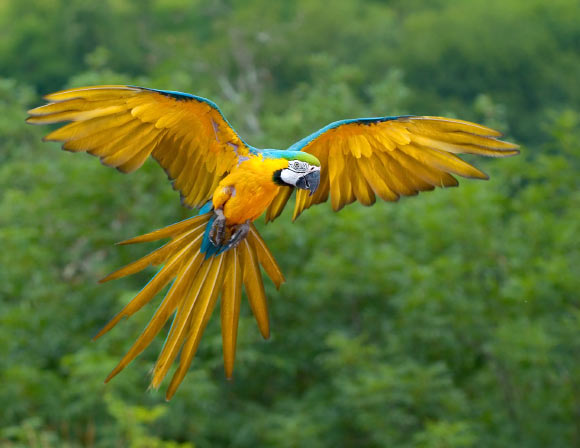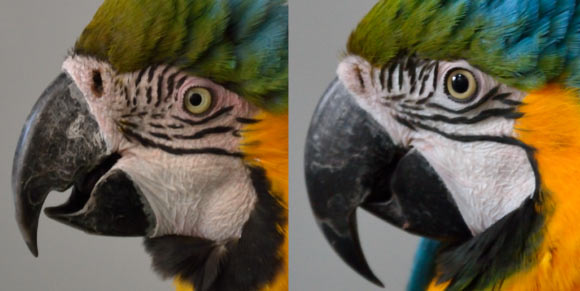Blue-and-yellow macaws (Ara ararauna) ruffle their head feathers and blush to communicate visually, according to new research from the ZooParc de Beauval & Beauval Nature and the INRA Centre Val de Loire at the Université de Tours, France.

The blue-and-yellow macaw (Ara ararauna) in flight. Image credit: Luc Viatour, Lucnix.be / CC BY 2.0.
The blue-and-yellow macaw is a member of the large group of Neotropical parrots and belongs to the genus Ara, one of six genera of Central and South American macaws.
The species occurs in South America from Venezuela to Brazil, Bolivia, Colombia and Paraguay. It is also found in Mexico and is restricted to Panama in Central America.
The bird is vivid in appearance with blue-green wings and tail, dark-blue chin, golden under parts, and a green forehead. It can reach a length of 30-34 inches (76-86 cm) and weigh 0.9-1.5 kg.
The blue-and-yellow macaw is known to scream for attention and to make other loud noises. Loud vocalizations and destructive chewing are natural parts of its behavior.
“How birds use facial displays and whether they communicate their inner subjective feelings is a question that is crucial to deepening our understanding of bird sentience,” said study lead author Dr. Aline Bertin, a researcher at the INRA Centre Val de Loire.

This is a ‘blushing’ blue-and-yellow macaw (left) compared to a ‘non-blushing’ macaw (right). Image credit: Arielle Beraud.
Dr. Bertin and colleagues studied five captive blue-and-yellow macaws interacting with one another and with their human caretakers.
The scientists assessed the feather position (ruffled or sleeked) on the crown, nape, and cheek, as well as the presence or absence of blushing on the bare skin of the cheek.
They found that feather ruffling was more common when the birds were not in motion, such as during social interactions and resting periods.
Crown feather ruffling and blushing were both more common when the human caretaker was actively interacting with the parrot by talking and maintaining eye contact than when the keeper was in the room but ignoring and turning their backs to the bird.
Together, these results suggest that head feather ruffling is associated with states of lower arousal and positive social interactions.
“Although caution must be exercised when interpreting these data due to the small sample size, we argue that crown ruffling and skin color variation may provide facial indicators of birds’ inner subjective feelings,” Dr. Bertin said.
“On a practical level, parrots are popular companion animals, with millions of parrots being kept as pets, and understanding visual communication in parrots may help to assess their well-being in captive conditions.”
“Blushing may not be a characteristic unique to humans: the featherless cheek of the blue-and-yellow macaw reveals rapid skin color changes in situations associated with emotion. The macaw’s particularly complex face may enable communication of emotion via color and feather displays.”
The study appears in the journal PLoS ONE.
_____
A. Bertin et al. 2018. Facial display and blushing: Means of visual communication in blue-and-yellow macaws (Ara ararauna)? PLoS ONE 13 (8): e0201762; doi: 10.1371/journal.pone.0201762







